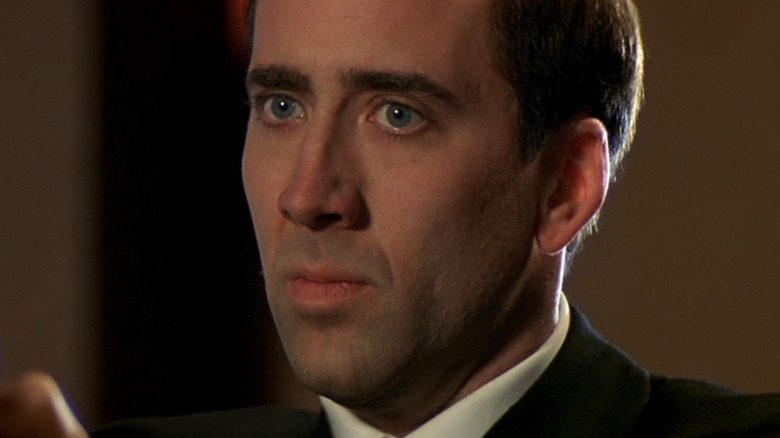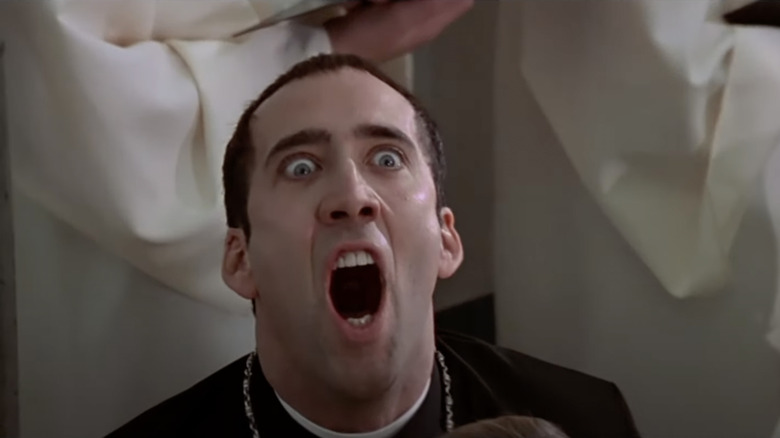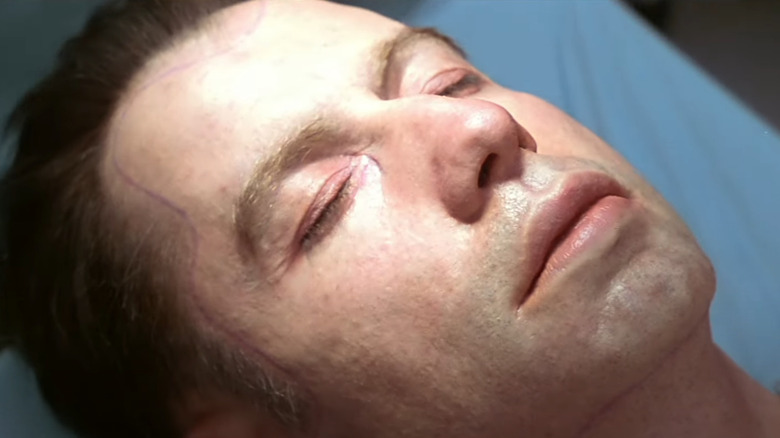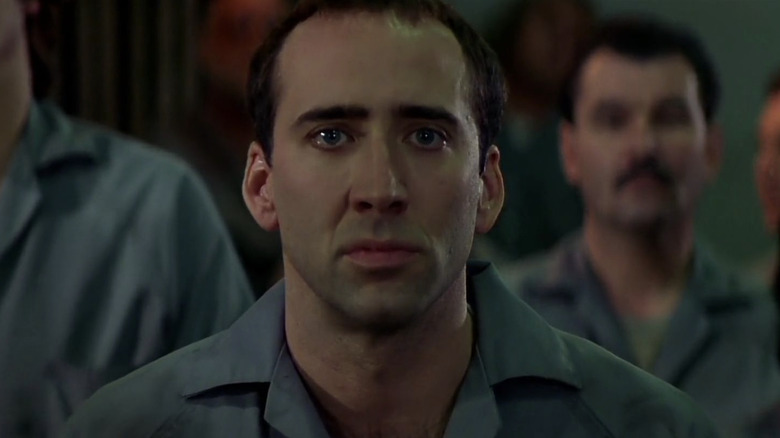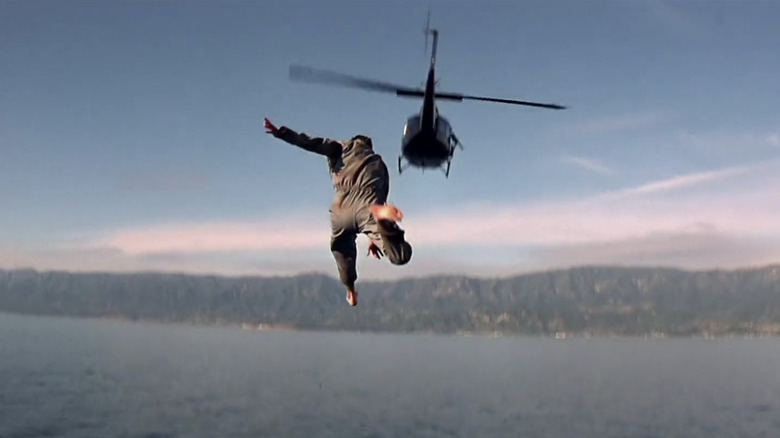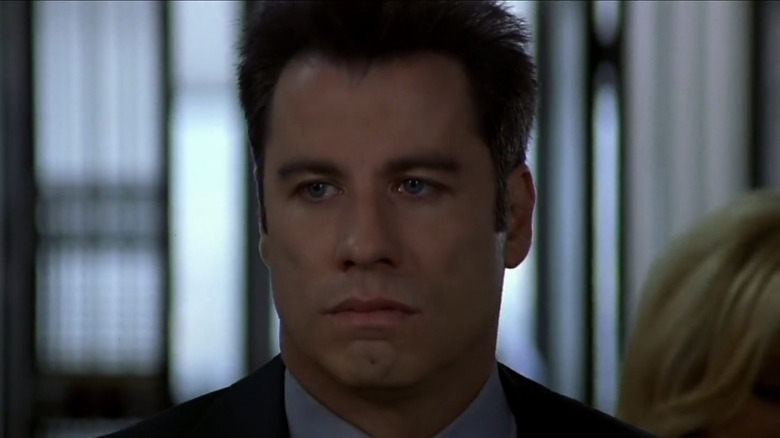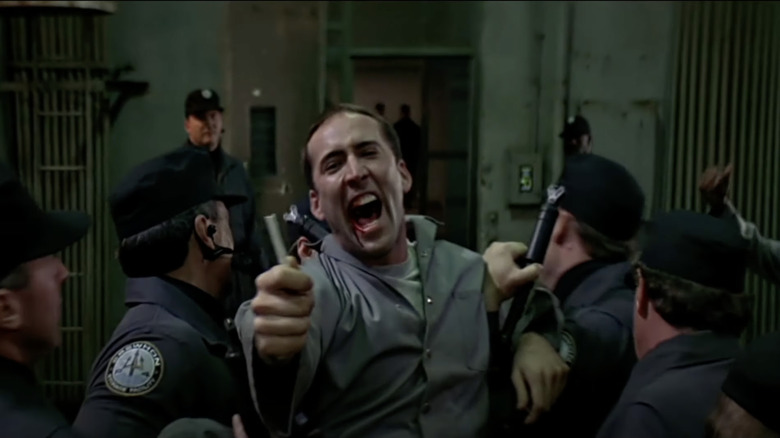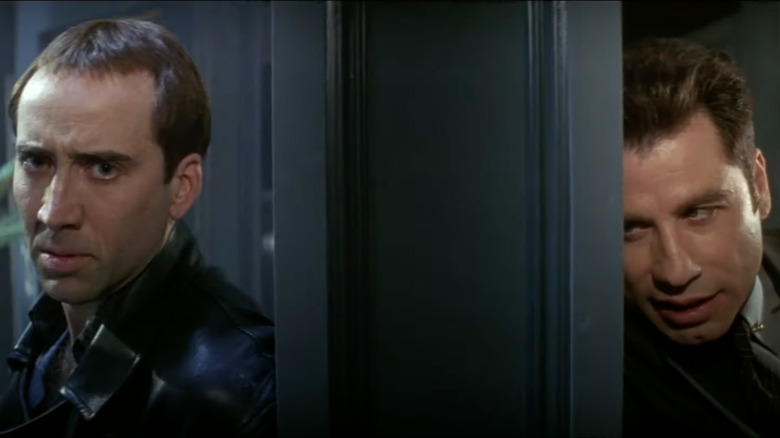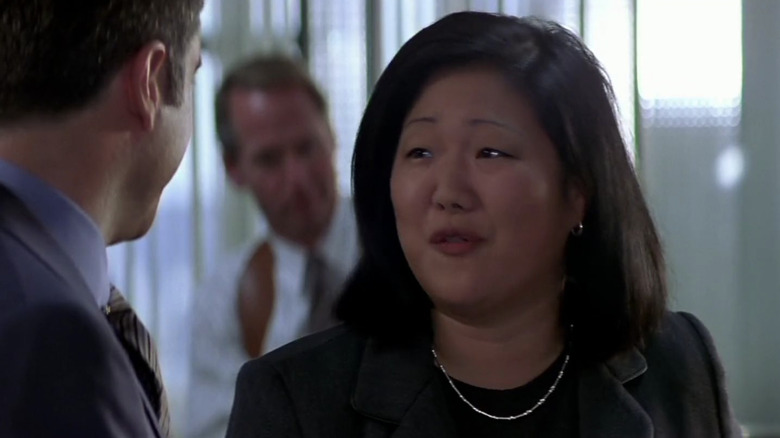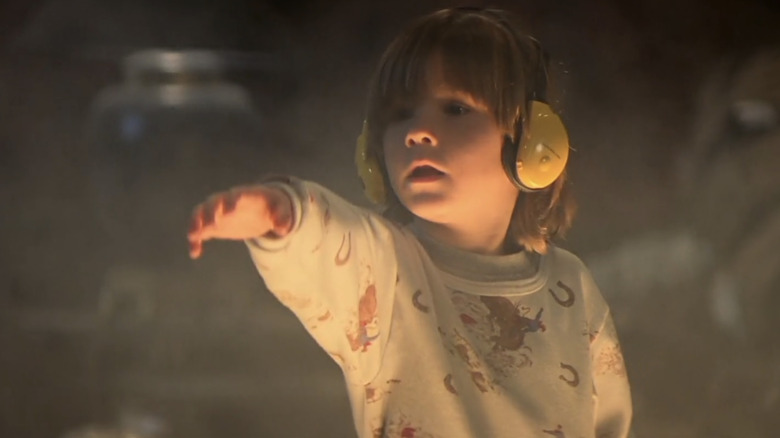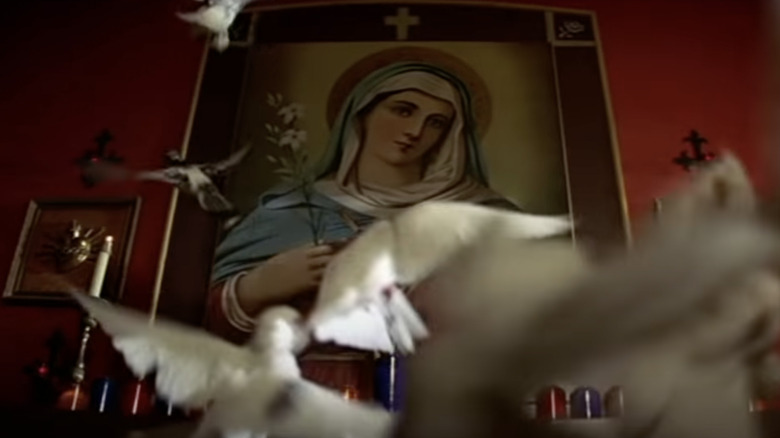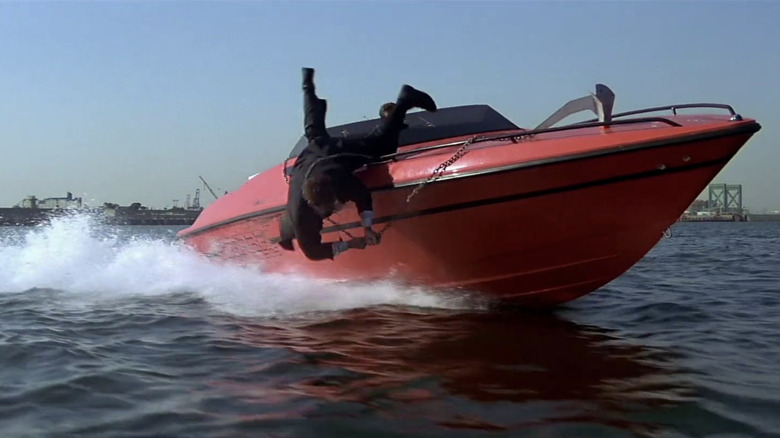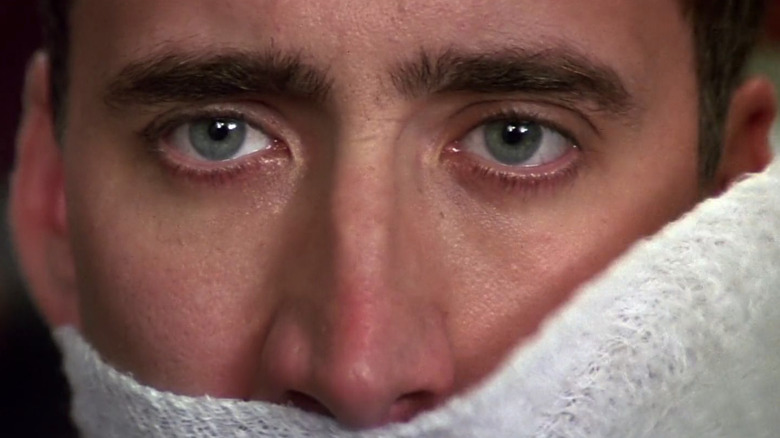The Most Pause-Worthy Moments In Face/Off
When "Face/Off" was released in 1997, audiences weren't entirely clear on what they were seeing. A review in The Washington Post described the film as "a delirious mixture of spectacular gun battles, furious explosions and breathtaking stunt work," while adding that "it's also one of the strangest stories to ever get the green light at a Hollywood studio." The premise is outlandish: To prevent an attack planned by terrorist Castor Troy (Nicolas Cage), FBI agent Sean Archer (John Travolta) goes undercover. This isn't your normal undercover job — through an advanced sci-fi surgery, Archer's face is removed and replaced with the captured Troy's. However, once Archer (with Troy's face) is on his mission, Troy gains control, forcing the surgeon to put Archer's face on his own naked skull. Consequently, Archer is living out in the world as Troy ... and Troy has taken over Archer's life, family and all.
Directed by John Woo, the film was an enormous success at the time, holding its own in a summer that also saw the release of "Men in Black," "The Fifth Element," and "The Lost World: Jurassic Park." "I have no problem with people saying it's crazy or it's insane or it's stupid," said co-screenwriter Mike Werb (via ShortList). "It's a fable." A blockbuster upon release, it has become a cult favorite and was prominently featured in Cage tribute "The Unbearable Weight of Massive Talent." Love it or hate it, "Face/Off" and the wild ride it provides have stood the test of time.
Hallelujah!
"Face/Off" introduces villain Castor Troy as a crazed man in a priest's robes, manically dancing around as a nearby choir sings the Hallelujah Chorus. He even sings along: "Hallelujah!" This introduction not only encapsulates Castor Troy's character, but it also shows how fully Nicolas Cage dives into the role, giving an over-the-top performance that would only work in a film such as "Face/Off."
Cage is well-known for his unique approach to acting, which he calls "Nouveau Shamadic." Den of Geek describes it, "Taking inspiration from the witch doctors of pre-Christian civilization, Cage prepares for each and every role by working himself into a trance-like state in order to connect with the character and the work."
Occasionally this approach led to a performance that was too much even by the standards of "Face/Off." Co-writer Mike Werb remembers a day on set when Cage asked Werb's opinion about a particularly dramatic take. "I saw my career flashing before me," Werb told Inverse. "I still can't believe this came out of my mouth, but I said, "You know, Nic, you'd make a great Captain Ahab some day. But we're shooting 'Face/Off.'" Werb went on to clarify that the performance seemed more like Troy than Archer, and Cage was supposed to be Archer in the scene. Though giving that kind of feedback made Werb nervous, the next day he was contacted by executives who asked him to help out when they needed to curb Cage's performance in the future.
The face surgery
Of course, one of the most iconic moments in "Face/Off" is when they take the faces ... off. (According to ShortList, the back-and-forth with the famous line "I'd like to take his face ... off" was ad-libbed by Nicolas Cage.) The facial surgery scene was the hinge upon which the film's premise turned. "I realized during the premiere during that [surgery] sequence that we had totally sold the idea," editor Steve Kemper told Inverse. "We knew right there and then that the audience was buying the idea."
Such a victory came from the hard work of the art and prosthetics crew working on the film. Special effects artist Kevin Yagher oversaw the creation of robotic doubles for both Cage and John Travolta. These doubles were painstakingly made, beginning with lifecasts and then outfitted with blood vessels that pumped and tiny motors that made it appear as if the bodies were breathing and moving. "It was so impeccably done that Travolta was kind of freaked out," art director Steve Arnold told Inverse. And Travolta wasn't alone — Cage found them just as disconcerting. "They made a clone of me, which is terrifying to look at. You could trip out on it," Cage said in a behind-the-scenes featurette for the film. "It breathes, and it twitches its face ... it's amazing."
Entering the prison
When Nicolas Cage (now John Travolta's character with Cage's face) enters the prison, the film takes a futuristic turn. This sci-fi prison, with its magnetic boots, was a vestige from earlier drafts of the script, which was set in the future and fell much more into the sci-fi genre (via Pajiba). However, producer Barrie Osborne had screenwriters Michael Colleary and Mike Werb take the story out of the future. And though the writers were skeptical that the audience would accept the futuristic face surgery, they agreed. "They went with it, thank God because that allowed me to cut $20 million out of the budget right away," Osborne told Inverse.
Another earlier iteration of the screenplay looked not at the future, but at the past. "We were very influenced by James Cagney's last great gangster movie, 'White Heat,' and the sequence that takes place in prison," said Werb (via Inverse). The writers were also inspired by the Attica Prison riot that took place in New York in 1971 (via The Independent). Colleary told The Independent they started with the idea of someone taking over the imprisoned character's life on the outside, and then "really backed into the idea of a facial swap" from there.
The prison-break jump
When Nicolas Cage began shooting "Face/Off," he had just come off of two other action films: "The Rock" and "Con Air." He was primed and ready for action. According to "Face/Off" weapons master Rock Galotti, "Nic's extremely, extremely athletic" (via ShortList). With Woo and stunt coordinator Brian Smrz putting an emphasis on practical effects, Cage ended up playing a large role in many of the stunts. This included getting strung up in a harness for the wind tunnel scene at the beginning of the movie (via Inverse).
However, there was one stunt that Cage would not take part in — the jump that ends the prison break sequence. Having staged a prison riot, Archer (with Troy's face) manages to get outside of the high-security prison, only to realize that the prison is inside an oil rig-like structure that is far from shore. He's stranded. And if that's not enough, helicopters arrive and shoot at him. There's only one way to go: down. And for Cage, who is afraid of heights, that wasn't going to happen. "I like Nic, but he definitely did not like heights at all," Smrz told Inverse. "We did get him up there. He does a small little run and jump and that's about it." From there, the stunt was performed by a world-champion high diver named Bob Brown.
The chin joke
When Troy is outfitted with Archer's face, he's not exactly pleased about his new looks. "This nose, this hair, this ridiculous chin!" he complains. Shortly before they began shooting, Travolta told the writers that he wanted to meet with them to go over some notes. He asked them about the rather personal joke. The writers quickly reassured him. "We said, 'John, the joke is that you're such a famously handsome person that saying that anyone would complain about looking like you ... that's the joke," co-writer Michael Collearly told ShortList. "But right now, you are Nic Cage! And Nic Cage as Castor Troy is a total narcissist — nobody is better-looking than he is!" (via The Independent).
Thinking of Travolta as one of the world's most famously handsome people may seem odd to audiences now far-removed from the 1990s. But Travolta was a heartthrob, between hits like "Saturday Night Fever" and "Grease," and he had just been dubbed "the coolest man alive" in the April 1996 Empire magazine (via The Independent).
The prison fight
When Archer-with-Troy's-face is in the prison, Troy's brother is suspicious at Troy's lack of rage. And so Archer-with-Troy's-face needs to exhibit pure, evil rage. This is one of the points in "Face/Off" where Nicolas Cage taps into the frenetic style of acting that he's known for. Cage recalls getting very into the scene and that he "just kept going for it" (via Entertainment Weekly). Cage said he had seen director John Woo's other films and knew that frenzied violence fit the director's style.
Others agreed. Neil Spisak, the production designer, described Woo as a "very charming and very sweet man," that is, "for a man who blows the s*** out of everything" (via Inverse). Ellen Mirojnick, the film's costume designer, told Inverse that Woo "uses blood better than most directors. The amount of blood was massive." Woo indeed let Cage go all-out for the prison fight scene. Screenwriter Mike Werb said that Woo only pulled things back once: "John Woo was saying you can't hit Nic in the face too many times. It should be more in the stomach because the audience might be afraid his face is gonna fall of" (per Pajiba).
For Cage, it remains a surreal memory. "There was a moment in there where I think I actually left my body," he told Entertainment Weekly. "I got scared, am I acting or is this real? I can see it if I look at the movie, that one moment, it's in my eyes."
Troy and Archer coming face-to-face
The layers of acting that are happening in "Face/Off" go deep, as not only are Nicolas Cage and John Travolta playing characters, but they're also playing another character with the wrong face. To achieve this effectively, "They spent a lot of time together and they spent a lot of time watching each other work," the film's editor, Steve Kemper, told Inverse. And it didn't just stop there. The two actors spent two weeks living together, studying each other's movements and idiosyncrasies (per Den of Geek). "I had an easier time of it than Nic did," Travolta told BUILD in 2019, "because Nic has a very specific style of attributes." Screenwriter Mike Werb agreed with this conclusion. "When Nic was Sean Archer, he had to act like he's Castor Troy but the humanity of Sean Archer has to bleed through at all times" (via The Independent).
While the Cage/Travolta duo is now iconic, the script was originally written with Arnold Schwarzenegger and Sylvester Stallone in mind (via The Independent). But they weren't the only pairs that writers Mike Werb and Michael Collearly considered. "Bruce Willis and Alec Baldwin! Mick Jagger and David Bowie!" Collearly said (per The Independent). He also said that Johnny Depp was in talks to star at one point, as were Michael Douglas and Harrison Ford (per The Independent).
Margaret Cho's appearance
Sean Archer's friend and coworker in "Face/Off" is played by comedian Margaret Cho. Cho had met John Woo through action star Chow Yun-fat, and she was thrilled to be part of such a big film. "This is like '90s action filmmaking where they could actually explode a plane without CGI," she told Collider. "This is before so many of these things were created with CGI. We had none of that. We only had planes and explosives."
However, the best part of the production, in Cho's experience, was getting to hang out with John Travolta. "He was a really jovial guy, really fun," Cho remembered, adding that one time she had lunch with him, "He ate an entire 9-inch boysenberry pie with a fork. No plates, no knives" (via Collider). "Everything John Travolta eats has a flaky crust," Cho joked on The Jess Cagle Show, adding that their rich lunches of beef wellington and pie meant that costumers sewed some elastic into her costumes to make them more accommodating.
Somewhere Over the Rainbow
Woo is known for his action sequences, which occasionally take on an almost balletic flair with their slow-motion beauty. "This man had taken violence and turned it into a ballet," Nicolas Cage said (via Den of Geek).
"I approached ['Face/Off'] like an opera because his work is sort of like that," said production designer Neil Spisak (via Inverse). For "Face/Off," this is most true during the shoot-out in Troy's loft, largely because the scene is underscored by the song "Over the Rainbow," which Troy's son, Adam (David McCurley), is listening to on his headphones.
According to Pajiba, Woo originally planned on using the song "Puff the Magic Dragon" but decided on "Over the Rainbow" due to his fondness for "The Wizard of Oz" and pleasant memories of watching that film as a child. Woo told the The Independent that he was worried the studio wouldn't leave the song in the finished film. "I'm so glad they left it in ... because it gave the killing scene so much meaning," he said.
The pigeons
Despite being known, in part, for the violence of his films, John Woo is a devout Christian, and puts symbolism in his films to express his faith. Specifically, he uses doves to symbolize the connection between man and God, the soul, and more. "Doves represent the purity of love, beauty. They're spiritual," he said (via Theology Gaming). When discussing his earlier Hong Kong film "The Killer," Woo explained that the image of doves flying, combined with the images of the bad guy dying, represented the soul leaving the body: "These guys have done some bad things in their lives but their souls got saved in the end, which I wanted to express through this image," he said (per ScreenRant).
While Woo was a very established filmmaker in Hong Kong, "Face/Off" was only his third Hollywood film. This meant that some of his colleagues weren't familiar with his trademark birds. According to Inverse, producer Barrie Osborne originally denied Woo's request for pigeons. But after seeing Woo's disappointment, Osborne said he wasn't able to sleep that night. The following morning Osborne said he went back to Woo and said, "John, if you tell me you won't wait for the pigeons to do something perfect, you can have the pigeons." According to Osborne, Woo's "face lit up." And the rest is history.
The boat chase
Looking back, due to the lack of CGI, the number of practical effects in "Face/Off" is monumental. "In the very first couple of days, we literally sunk a boat," recalled stunts coordinator Brian Smrz (via Inverse). This was part of the climactic boat chase, which ends with a boat crashing, getting flung up into the sky, and exploding (all in slow-motion, of course).
The sequence was done with practical effects, and according to art director Steve Arnold, producer Barrie Osborne wanted to "try and do as much in camera as possible" (per Inverse). The exploding boat that appears in the film is quite the feat. "We had bought a cabin cruiser, we had completely cut out the guts, and they built a little ramp with rails; and then the cabin was all balsa wood painted up to look like the real thing," said Arnold (via Inverse). "And this blind driver [a driver who is inside the boat, off camera] drives the boat up the back of this other boat, and the stuntmen jump off, and as it flies through the air in somewhat slow motion you can see the propeller turning. That was all real."
The sequence took four weeks to film, and Cage's stand-in Marco Kyris says it was stressful, and included "several mishaps" (via ShortList). He told ShortList that "Nobody lost a life, but there were some accidents."
The ending
The film ends with Archer reinstalling his own face and bringing home Troy's son, apparently to adopt as a sort of "replacement" for Archer's son, whom Troy kills at the beginning of the film. That ending very nearly did not make it into the finished film. Studio executives said the ending was "European" and that American audiences would not accept that Archer would take in Troy's kid (per Inverse). But then, Mike Werb said, "There was a test screening; the report came back that over 65% of the audience took the initiative to say, 'What happened to that little boy?'" With that, the studio agreed to film the originally planned ending.
On the Blu-ray release of "Face/Off," you can see another alternate ending that suggests that Castor Troy isn't totally gone — an evil grin from Archer's face seems to suggest the faces weren't returned to their rightful owners. "I think they were trying to imply that Sean Archer is possessed in some way by Castor Troy or his experience of being Castor Troy will forever haunt him in some supernatural way," said Simon Barrett (via Showbiz CheatSheet), though he made it clear he prefers the original ending. Barrett, screenwriter, along with director and co-writer Adam Wingard, signed on to create a sequel to the 1997 film in 2021 (via Deadline). But it'll be tough to top the action-packed madness of John Woo's original.
